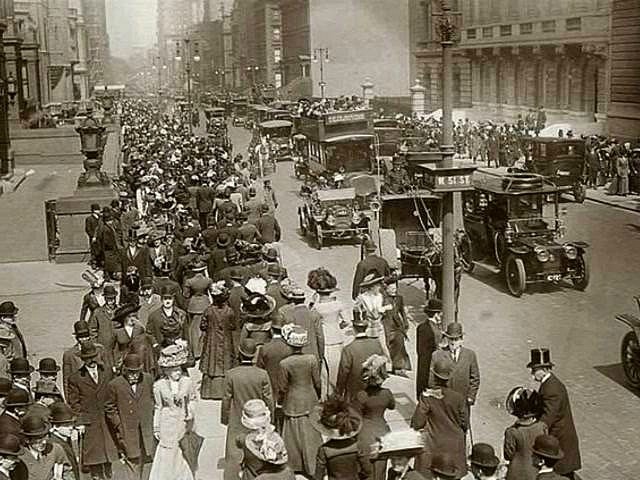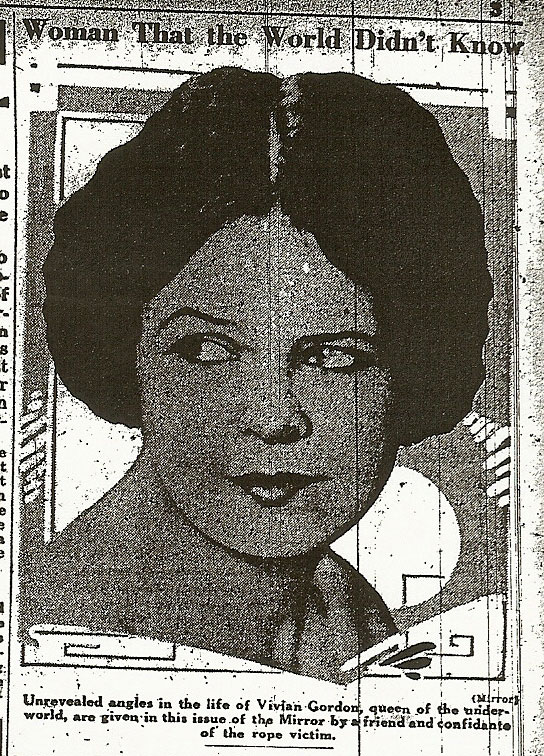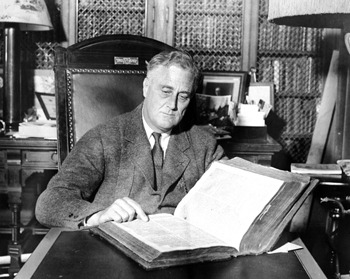The Dead Woman Who Brought Down the Mayor
Vivian Gordon was a reputed prostitute and blackmailer—but her murder led to the downfall of New York Mayor Jimmy Walker
![]()

An early 20th century street scene in New York City. Photo courtesy of Flickr user Leo Bar PIX IN MOTION
Besides her killers, the elevator operator was the last person to see Vivian Gordon alive late on the evening of February 25, 1931. A petite redhead about 40 years old, Gordon was wearing an ankle-length mink coat, a platinum watch and a two-carat diamond ring when she left her posh, three-room apartment at 156 East 37th Street in Manhattan around 11 p.m. and got into a Cadillac.
As the toxicologist would discover, at around 1 a.m. she probably ate some sauerkraut, raisins, “the white of egg, onions and celery” and had enough to drink so that her blood alcohol was 0.2 percent. Shortly after that, Gordon was beaten on the head, strangled with a piece of rope and possibly dragged from the car for an indeterminate amount of time. Her body was dumped in Van Cortland Park, near the cemetery and the golf course, where an oil company worker discovered it on his way to the office at 8:20 a.m.

A newspaper treatment of the Vivian Gordon murder. Scan from the New York Mirror
According to the police report, Gordon was wearing a black velvet dress with lace trim and one white kid glove. The other glove lay nearby. A black straw hat and a black suede pump with a rhinestone buckle were found not far away. She was coatless, and her ring, watch and pocketbook were missing.
The case of Vivian Gordon obsessed New York City for weeks. It was on page one of every newspaper and on the covers of magazines. Herald Tribune columnist Heywood Broun covered it, and the Evening Post began “The New School of Murder,” a series about the rise of “the smartest” professional killings. Fictionalizations were sold. Several newspapers, including the Post, compared Gordon’s murder with that of Herman Rosenthal, who in 1912 had been slaughtered in cold blood for threatening to expose police corruption. The difference was that Gordon’s murder would lead to a real investigation into police practices.
Reading about the case in the newspapers in Albany, Governor Franklin Delano Roosevelt immediately telegrammed Charles McLaughlin, the Bronx district attorney, to ask for the police report. He suspected there was a connection between Gordon’s murder and police “frame-ups,” and he was determined to get to the bottom of it. He had already empowered former judge Samuel Seabury, a crusader against Tammany Hall, to investigate corruption in the magistrates’ courts, where police and judges framed innocent women as prostitutes. But Gordon’s death would inspire Roosevelt to give Seabury broader powers still, one result of which would be that in 1932, New York City’s good-time Mayor Jimmy Walker would be indicted on charges of corruption.
Gordon was born as Benita Franklin in 1891 in Joliet, Illinois. Her father, a prison warden, sent her to the Ladies of Loretto Convent nearby, where she was described as “insubordinate” and tried to kill herself. After running away from the convent, Benita worked as a chorus girl for a while. In Charleston in 1912, she met a man named John Bischoff and became his common-law wife. Three years later, Gordon gave birth to a daughter, whom she named Benita. She fled to New York in 1920.
It is not clear when or why she took the name Gordon or what happened from the time she moved to New York to the moment she was arrested in 1923. But when Vice Patrolman Andrew J. McLaughlin nabbed Gordon at the Langwell Hotel in the arms of her lover, Al Marks, a lingerie salesman and ex-con from Long Branch, New Jersey, Bischoff was filing for divorce. Gordon was convicted of prostitution and sentenced to two years in the Bedford Reformatory, and Bischoff got custody of Benita. The desperate mother would contest the custody decision three times, without success.
Meanwhile, she became what the police would describe as “a woman of many acquaintances” and a scam artist. Or, as the New York Times put it, she was in “the blackmail business” and lent money to gangsters.

Franklin D. Roosevelt, once the 44th governor of New York. Photo courtesy of U.S. Embassy The Hague
By 1931, Gordon had reason to be afraid of many people. Perhaps emboldened by reading about Seabury’s investigations in the paper, in January she wrote her ex-husband—who was by then living in Philadelphia—threatening to reveal his “dirty frame-up” to her daughter and anyone else who would listen. She wrote a similar letter to Officer McLaughlin. On February 7, she wrote to the Seabury Commission to say she wanted to testify that McLaughlin and Bischoff had conspired to frame her eight years earlier in order to seize custody of her daughter.
On February 20, five days before she was strangled, Gordon appeared at 80 Centre Street to tell Seabury lawyer Irving Ben Cooper her story. She left promising to seek corroborating evidence.
Besides squealing, Gordon had other reasons to be afraid. Searching her apartment, the police found diaries mentioning over 300 names—nearly every major gangland figure in New York and prominent businessmen, like the philanthropist Henry Joralemon and John Hoagland, the baking-powder emperor. The notorious madam Polly Adler was there as well. “ just another woman out to feather her nest quickly,” Adler said.
One way Gordon feathered was by blackmailing wealthy men. A number of gangsters owed her money. She owned buildings in Queens that seemed to be gambling dens. But her diaries named John Radeloff —her lawyer and once her boyfriend—as the “only man I fear.”
Hundreds of police officers were put on the case, and a grand jury was convened. The first people to be interviewed were Radeloff and his associate Sam Cohen, aka Sam Harris aka Chowderhead Cohen, an ex-con Gordon also mentioned in the diaries. The grand jury concluded that the men were hiding something, and they were each held on $100,000 bail.
As the police continued to read the diaries, they discovered another candidate for Gordon’s murder: Joseph Radelow, another ex-boyfriend, her partner in a stock swindle and Radeloff’s cousin. In 1930, the duo fell out after he declined to pay Gordon some money he owed and she testified against him, revealing their “immoral” relationship in front of a grand jury. But the police could find no record of this hearing.
The more the police dug, the more suspects and motives they found. According to a call girl named Helen Dorf, the deceased was a “gold digger.” But Gordon was more like a central bank for criminals. She had advanced the Bronx racketeer Harry Stein funds to commit either bank fraud or start a bootlegging racket in Oslo, of all places. There was speculation that she had been involved with dope and all manner of extortionists and criminals, from Legs Diamond to Arnold Rothstein to the “Long Beach Liquor Mob.”
As the investigation revved up, reformers and educators began to speak out more boldly against corruption in city government than anyone had. John Dewey demanded reform. Rabbi Stephen S. Wise and the Reverend John Haynes Holmes demanded a “swift” investigation and a sweeping examination of corruption in Jimmy Walker’s office. Wise and Holmes were even emboldened to urge Walker to resign, which he declined to do.
In 1931, although Seabury was careful to stay out of the murder investigation and focus on corruption, he personally interviewed some witnesses relevant to the former. He was the first to hear Cassie Clayton, a friend of Gordon’s—and a possible associate of Legs Diamond’s—testify that the victim was obsessed with getting revenge on the men she believed had stolen her daughter.
By March 1, the case had attracted the attention of someone who wished to stop it. Considering that Seabury relied heavily on informants to make his case against the magistrates, it was not surprising that he received several death threats from one “Dr. X,” warning him that Gordon’s fate was evidence of what happened to “squealers.” These threats, written in longhand on telegram forms, immediately were turned over the police, but Dr. X’s identity was never determined.

Judge Samuel Seabury. Photo courtesy of Library of Congress
Officer Andrew McLaughlin was aboard the S.S. California on a six-day Cunard line cruise to Bermuda when Gordon was murdered. After the California docked back in New York, McLaughlin was interviewed by the grand jury. At first he denied remembering anything about her. But the next day, he recalled the dead woman “flirting” with him in 1923.
Roosevelt called Seabury to Albany, probably to discuss the murder investigation, which seemed to have stalled. Asked by the New York Times if he was pursuing any particular persons of interest, Bronx District Attorney Charles McLaughlin (no relation to the patrolman) replied, “Yes, everybody in New York.”
And then on March 4 came a shocking development: Gordon’s 16-year-old daughter killed herself. “I can’t face the world,” she wrote before she turned on the gas.
The outcry from religious figures and reformers surged. Rabbi Wise and Reverend Holmes again spoke out. Two bishops deplored the “wave of lawlessness.” The murder investigation seemed to regain strength. Roosevelt announced that he would launch an investigation of corruption in New York City government. The police, he said, were “on trial.” The Pinkerton Detective Agency was called in to help with the Gordon case; old timers at the police department groused that that had never happened before. Roosevelt named Seabury “special investigator” and launched a parallel investigation into possible misconduct by the ancient Manhattan district attorney, Thomas C. Crain. While the police pursued Gordon’s murderer, special hearings were convened to determine whether there had been judicial misconduct in her 1923 arrest.
It seemed that there had been. Testifying in one of these hearings on March 9, Magistrate H. Stanley Renaud, who had seen Gordon in appellate court that year, was “flushed and nervous.” He said he didn’t remember Gordon. And the minutes of that hearing had been destroyed.
Seabury’s deputy pointed out that Vivian Gordon was a first offender and would not have ordinarily been sentenced. (One thing Seabury focused on was whether judges delivered harsher sentences to first offenders, especially those declining to reveal personal information about themselves.) Renaud evaded the question, instead referring to Bedford Reformatory as a “wonderful school” that anyone would be glad to go to. At the same time, Manhattan D.A. Crain tried to stop Seabury’s investigation into him by offering to cooperate if the judge ceased his special hearings into the magistrates.
And then on March 13, there was a break in the Gordon case. Investigators found that Officer McLaughlin had deposited $35,800 in his bank account over a period of two years when his salary was $3,000 a year. McLaughlin declined to say where he had gotten the money, citing his constitutional rights and accusing Seabury of exceeding his investigation’s authority.
At his hearing, McLaughlin was cavalier, claiming to have made as many as 1,200 vice arrests in ten years, roaming up and down Broadway arresting women, working through his lunch break. He usually worked alone, though he did not want to be called a “lone wolf.” But apparently this lone wolf, while interrogating witnesses, pummeled them with their previous crimes until they confessed to imaginary new ones.
The NYPD speedily released McLaughlin, and he was never charged with framing Vivian Gordon. Nor was the precise source of the $35,800 ever learned. The same morning, Seabury presented H. Stanley Renaud, the magistrate in Gordon’s 1923 arrest, with a table showing that witnesses who protested their innocence in his court fared worse than those who. Renaud confessed that justice had not been served in his court.

New York Mayor Jimmy Walker. Photo courtesy of Library of Congress
On March 18, the City Affairs Committee demanded the removal of Jimmy Walker, who was vacationing in California at the time. Walker dismissed any accusation of police corruption and denied responsibility for corruption in the courts. But the pressure on him was building.
Three weeks later, the police finally dredged up some suspects in the Gordon murder case: The racketeer Harry Stein was indicted. He pleaded not guilty, although the police had collected proof that he had disposed of Gordon’s belongings the day after she died. By May, another indictment followed: Stein’s pal Samuel Greenhauer, a tailor.
And then the police found Harry Schlitten, who was alleged to have driven the murder car. For testifying against Stein, Schlitten was given immunity. Jimmy Walker, having returned from California, applauded the police action and said the arrests proved that there had been no cover-up. Yet even before the trial began, at least some journalists were wondering whether about the convenience of it all. “If by some odd quirk of fate, Mr. Stein should be found not guilty (and what an odd quirk that should be) a good lawyer could make quite a bit of money,” the New Yorker opined.
The trial commenced on June 18. A parade of underworld figures testified. Among the most damning pieces of evidence came when Schlitten told the jury that Stein had pointed out a newspaper photo of Radeloff and identified him as the person who hired him to kill Gordon. Schlitten said Stein told him that Radeloff had threatened a gangland colleague with jail if he didn’t comply. As it turned out, both of the alleged murderers had alibis. Greenhauer was sitting shiva (mourning) for his mother, his family swore. Stein was with his sister at the movies and then a Chinese restaurant. On July 1, after just three hours of deliberation, the men were acquitted.
A representative from the grand jury that had convened in February to investigate Gordon’s death immediately presented the judge with a sworn statement saying that the verdict was a “shock.” The Bronx district attorney would later call the trial “a gross miscarriage of justice.”
The Vivian Gordon case continued to haunt New Yorkers. Seabury was never happy with the verdict. He felt that Stein and Greenhauer had materialized to cover up police corruption. He kept investigating their alibis, but to no avail. As for Walker, he would think about the Vivian Gordon case long after the trial. “There are still more frames than there are pictures,” Walker told his fans in May 1932, only a few months before Roosevelt, aided by Seabury, finally forced him to resign. It could not have happened without the dead woman in Van Cortland Park.